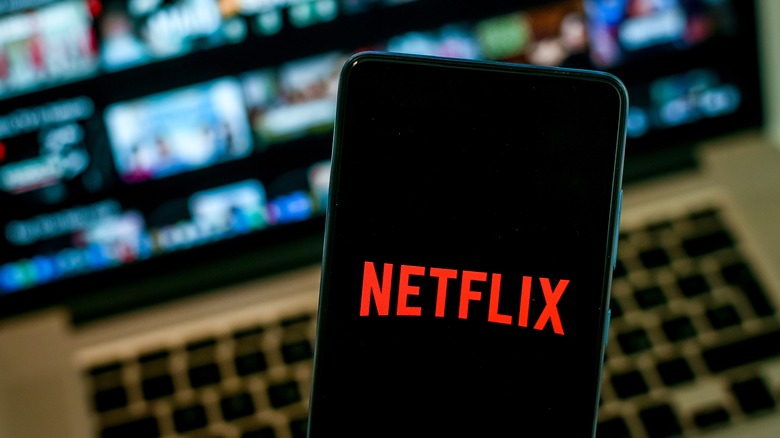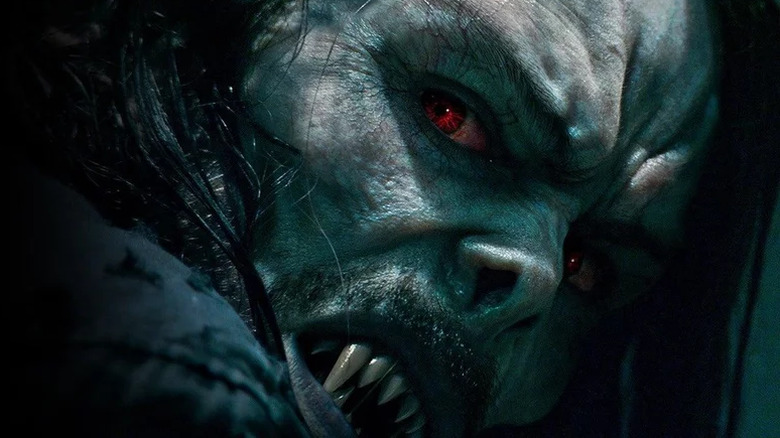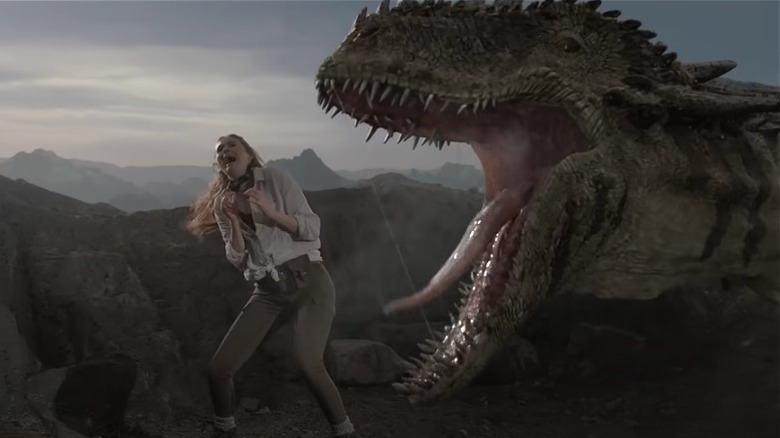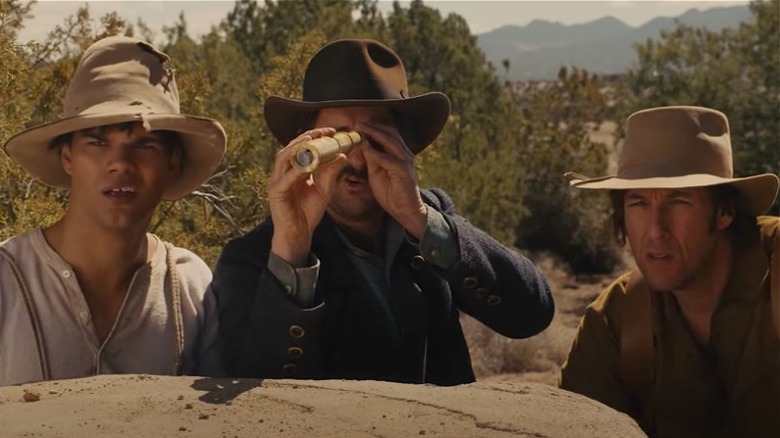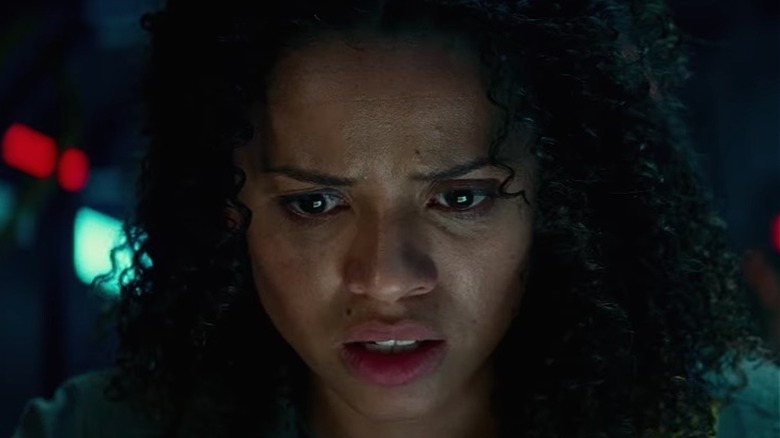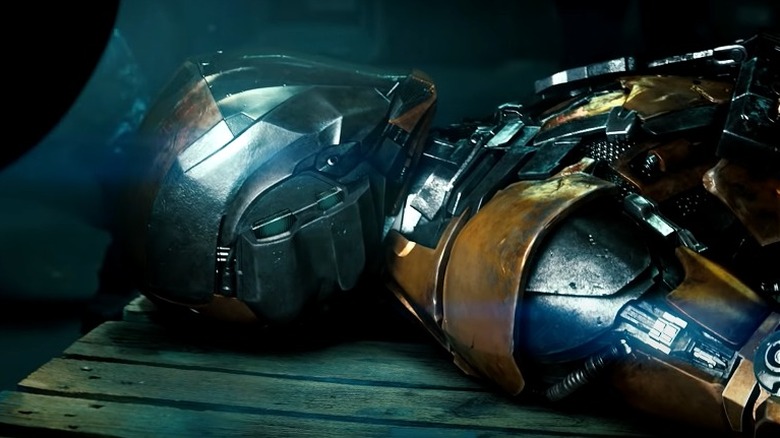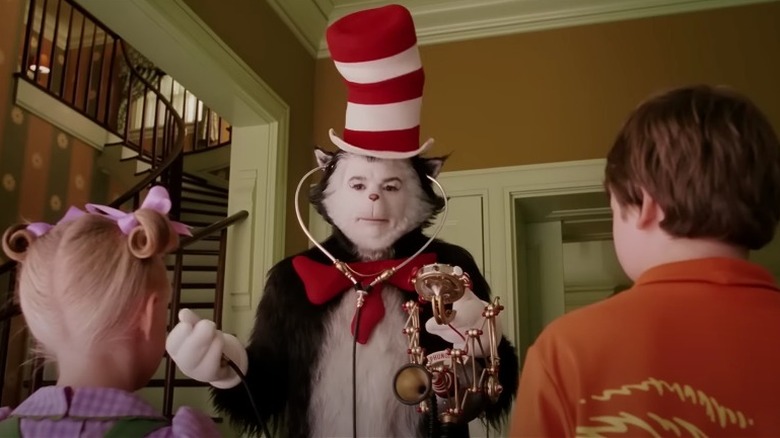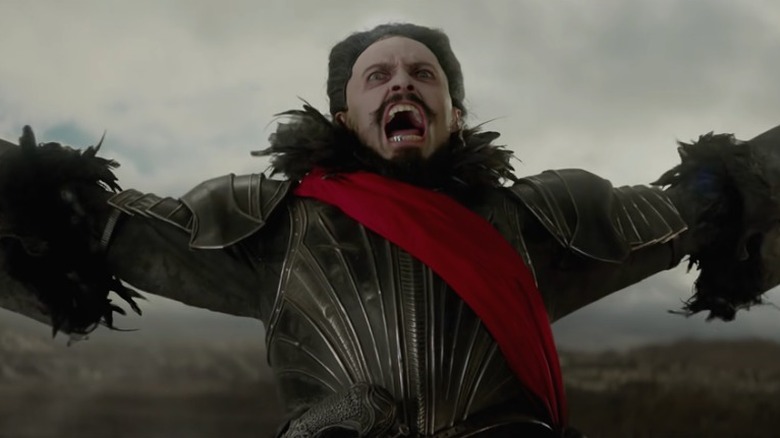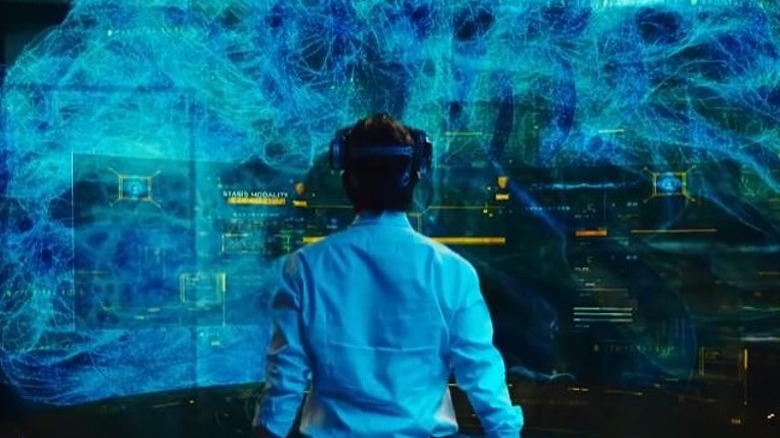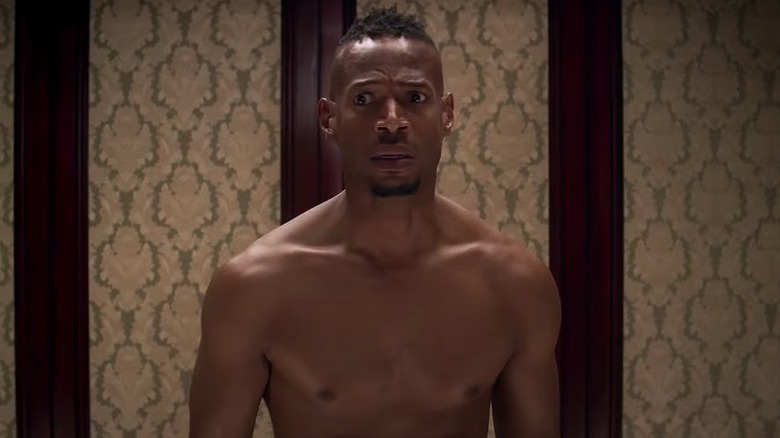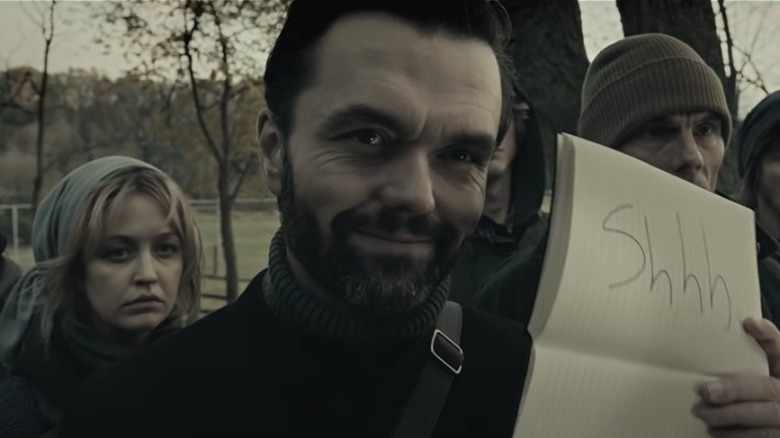10 Of The Worst Movies On Netflix Right Now
It wasn't that long ago that access to entertainment media came at a premium. Choices were limited to whatever was airing on live television and what you owned in your personal home movie library. If you wanted to see something new, you had to check the programming schedule and set a reminder, visit a theater, or take an outing to the video store for the latest VHS tapes. So hungry for stories were we that we'd happily drop several dollars a day to rent a movie and watch it at home.
These days, consumers have the opposite problem. We are constantly flooded with wave after wave of movies, all delivered automatically to television screens through the internet tubes. Even if Netflix never added another piece of content to its library, you could probably spend a lifetime watching and never get to the end. That said, not all movies are created equally. Unless you actually have a lifetime to devote to consuming stories, some are better left on the shelf.
Of course, this list isn't meant to yuck anyone's yum. There's a movie for every person and a person for every movie. Still, if you're looking for a quality cinema experience, you might want to avoid these titles on Netflix.
Morbius
You probably knew this was going to be here, so we might as well knock it out right at the top. "Morbius" is the third film in Sony's expanded Spider-Man universe, alongside two "Venom" movies. It stars Jared Leto as the titular Morbius, a doctor experimenting with artificial blood treatments for medical applications.
See, Morbius has a rare blood disorder that reduces his quality of life and could eventually kill him. Just to add a little extra motivation, Morbius' surrogate brother Milo (played by the always charming and deliciously smarmy Matt Smith) has the same disease and is in desperate need of a cure. The only trouble is that the cure in question also turns patients into bloodthirsty vampires, with all of the cool abilities and none of the typical weaknesses.
Most of Sony's MCU-related Spider-Man stories have been successful, but "Morbius" is the exception to that rule. The movie was a commercial and critical failure upon release, but has survived in the public consciousness much longer than it should have, mostly because of memes. Sony foolishly misinterpreted the cultural cache the film had garnered and issued a second theatrical release shortly after the premiere, only to be embarrassed at the box office a second time. Now you can watch it alone at home, where no one can judge you.
The Bubble
On paper, Netflix's "The Bubble" should have been an instant classic. Written and directed by Judd Apatow, the reigning king of theatrical comedy, it's supported by a star-studded cast including Karen Gillan, Fred Armisen, David Duchovny, Keegan-Michael Key, Leslie Mann, Kate McKinnon, and Pedro Pascal.
While much of popular culture has entirely ignored the COVID-19 pandemic, "The Bubble" not only acknowledged the existence of the coronavirus and the ensuring string of quarantines we endured, but also made it a central plot point. The story follows a collection of B-list celebrities holed up in a hotel together while they make the latest in a string of hokey science fiction films, where things go terribly wrong. Unfortunately, in an effort to make a comedy about a bad movie, Apatow and co. instead just made a bad movie.
By the time the credits roll, we end up with a movie about a movie about another movie — which is the perfect example of how the movie gets so navel-gazey that it curls up into itself and dies. "The Bubble" might have been an opportunity for a bunch of funny and talented people to poke fun at a global trauma we all experienced, but the execution just didn't work. In the end, "The Bubble" is left feeling forced and flat.
The Ridiculous 6
When Adam Sandler is first on the call sheet and the biggest name on the poster, you know you're about to get something either shockingly good or painfully absurd. "The Ridiculous 6," unfortunately, falls into the latter camp. A Western comedy from Sandler's own Happy Madison Productions (named for the two movies that launched his career), "The Ridiculous 6" sees Sandler as a down-on-his-luck cowpoke named Tommy. Like countless people before and since, Tommy dreams of a better life, and he just might get it if he and his five half brothers — played by Terry Crews, Jorge Garcia, Taylor Lautner, Rob Schneider (of course), and Luke Wilson — can find and save their deadbeat dad.
There's enough talent onscreen that a half-decent movie should have been almost guaranteed. Instead, we got two hours of disjointed sight gags and bad puns, all painted over with a layer of racism. It's the theatrical version of your uncle saying something ignorant at family dinner and then passing it off as a joke. Everyone is a little uncomfortable and nobody is laughing. What's worse, it was made recently enough that everyone involved should have known better.
Sandler flicks are hit and miss, filtering themselves into the two extremes of the bell curve. When they are good, they are really good. When they are truly bad, they are "The Ridiculous 6."
The Cloverfield Paradox
In the not-so-distant future, humanity is on its way down the proverbial drain unless we can come up with a long-term renewable energy solution. Researchers develop a powerful particle accelerator which could solve our problems, but it might also rip a hole in reality. In an attempt to protect the Earth from the potential side effects of the accelerator, they put it into low orbit with a crew of astronauts on a mission to save our species.
There were similar concerns with the CERN supercollider before it fired up, with some believing it would open up a black hole and swallow the world. In "The Cloverfield Paradox," those fears are borne out when the accelerator tosses the crew into a parallel reality.
Originally based on a spec script called "God Particle," the movie was eventually folded into the "Cloverfield" mythos under the direction of J.J. Abrams. That was achieved after the fact, by adding scenes and tacking on references to the Cloverfield phenomenon. The result is a movie fighting against itself. There are some sequences which work really well, but the slapdash creative process bleeds through.
Perhaps the most frustrating thing about "The Cloverfield Paradox" is the ghost of the movie it might have been. Iin an attempt to pull it into an existing mythos, the creators harmed the movie they were making and the existing IP they wanted to round out.
Battleship
As a board game, "Battleship" has all of the window dressing of a high stakes battle simulation, but it's actually one of the most mellow games you can play. For the uninitiated, each player is given an oceanic playing field laid out on an alphanumeric grid, along with a collection of warships. At the start, each player sets up their fleet before taking turns dropping bombs blindly into the water.
It's a game of luck and strategy, during which players probe a watery expanse they cannot see in hopes of sussing out the enemy before the last of their ships sink into the depths. Not knowing what's happening on the other side of the board is part of the intrigue; by design, you're supposed to be in the proverbial dark. All of that should have warned us not to expect much from a bright and glossy film adaptation. Yet, somehow, the 2012 live action film still disappoints.
In 2005, a potentially habitable planet known as Planet G is found, triggering the manufacture of an interstellar communications array. Years later, aliens arrive and send our satellites crashing through the atmosphere. What follows is an all out fight for the survival of our species. All of that sounds fine enough, but it isn't "Battleship." We've played that game hundreds of times and not once did a single alien ever show up.
The Cat in the Hat
Following the success of the Jim Carrey-starring adaptation of "How the Grinch Stole Christmas," Universal and DreamWorks were keen on keeping the Seuss train chugging along, and "The Cat in the Hat" was the obvious choice.
Based on the 1957 children's book of the same name, "The Cat in the Hat" follows the misadventures of two ordinary children named Conrad and Sally (Spencer Breslin and Dakota Fanning, respectively), who are left at home with a babysitter while their mother is out of the house. A sequence of increasingly wacky misadventures leaves the house in tatters and the clock is ticking before mom comes home.
The movie isn't all bad. Production designers largely succeeded in capturing the feel of Seuss' fictional world, and even the cat himself (played by Mike Meyers) looks like a character who might actually exist in that world. It appears, however, that so much focus was put on design that none was left for a good script. The pedigree of the source material, the people involved, and Seuss' trademark aesthetic design should have made "The Cat in the Hat" a slam dunk, but it somehow fails to be either entertaining or funny. Perhaps stretching 20 page children's books into two hour movies is a bad idea.
Pan
J.M Barrie's "Peter Pan" is one of the most enduring stories ever told. Since its release as a stage play a little over a century ago, the story has been translated into countless languages, adapted into a novel, and made into several films.
This particular version from director Joe Wright offers an alternative origin story for Barrie's most famous characters, Peter Pan and Captain James Hook. The movie stars Levi Miller as the boy who won't grow up, Garret Hedlund as a young Captain Hood, Rooney Mara as Tiger Lily, and Hugh Jackman as the pirate Blackbeard. Forgoing the time-tested rivalry between Pan and Hook, "Pan" instead teams them up against a fictionalized Blackbeard.
Concerns over the casting of Mara as the indigenous princess Tiger Lily tainted the movie's reception even before its release. Admittedly beautiful action sequences are also intercut with bizarre choices, like Blackbeard and his pirate band breaking out into a version of Nirvana's "Smells Like Teen Spirit." Despite a solid cast, a respectable budget, and some of the most beloved source material on the planet, "Pan" failed to capture the magic of Neverland or the interest of moviegoers.
Replicas
Listen, we love Keanu Reeves. We want that on front street before anything else is said. But Reeves doesn't always choose the highest caliber projects, and his particular style of acting isn't always right for every role. Such is the problem with "Replicas."
The story follows William Foster (Reeves), a neuroscientist working on a process for transferring human consciousness into synthetic or cloned bodies. The work is slow going and has hit some considerable roadblocks, but Foster gets a burst of motivation when his entire family is killed in a car accident. Foster steals equipment from the lab in a frantic attempt to resurrect his family before it's too late. Of course, things go terribly wrong, and the immortal house of cards Foster has built begins to crumble around him.
The trouble with "Replicas" is that you're never quite sure if Foster is a man on a noble quest to save his family or a madman with a god complex. As a result, you'll find yourself simultaneously rooting for Foster to succeed and regain the life he lost and for someone to kick down the door and put him in handcuffs. Despite an interesting concept and the presence of Reeves, there's just not enough to make "Replicas" worth resurrecting for a rewatch.
Naked
The "Groundhog Day" premise of reliving the same period of time over and over again has been trotted out a bunch of times at this point. "Edge of Tomorrow," "Russian Doll," "Happy Death Day," and "Palm Springs" have all done their take on the trope with varying levels of success. But that didn't stop Netflix from dragging it out one more time for the comedy "Naked."
The movie stars Marlon Wayans — practically comedy royalty not too long ago — as Rob Anderson, a man who wakes up naked in an elevator on the morning of his wedding. With the clock ticking, Anderson attempts to make it to the church, but is arrested for public indecency and the church bells ring while he is still in custody. Fortunately (or unfortunately, depending on your perspective), Anderson suddenly reappears back in the elevator, an hour earlier, with an opportunity to try again.
When a concept as well-trodden as living the same time over again, you really need to knock it out of the park to stand out. You wouldn't remake "Groundhog Day" just to do a bad job at it. Sadly, "Naked" seems more interested in how funny it is to get Wayans naked in the elevator (it isn't) than the very human elements at play. Audiences will go with your wacky premise if you give them a reason to care. Even in comedies, that's what viewers buy a ticket for.
The Silence
"The Silence" was a victim of lackluster execution and poor timing. Based on the novel of the same name, "The Silence" takes place in a post-apocalyptic world under attack. Mysterious flying creatures patrol the skies of the world, hunting down every human they can find using sound.
The story follows one particular family, including their deaf daughter, as they try to survive the end of the world. If all of that sounds familiar, it's because "The Silence" shares a lot in common with "A Quiet Place," which hit theaters a year earlier to plenty of acclaim.
It's not that "The Silence" is a copy of "A Quiet Place." It isn't, but the premises are too similar to avoid comparison. "The Silence" had plenty to work with, but just doesn't capitalize on the premise in a meaningful way and is likely to be forever overshadowed by its more successful counterpart. It's evidence that a cool idea will only get you so far; it's the execution that really matters.
